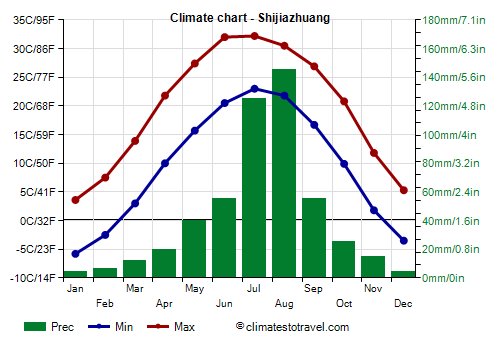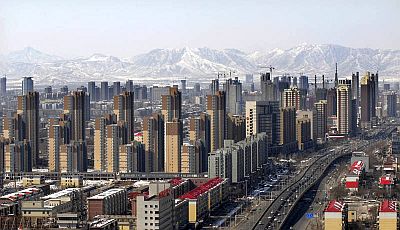Select units of measurement for the temperature and rainfall tables (metric or imperial).
Average weather, temperature, rainfall, sunshine hours

In Shijiazhuang, the climate is
continental, with cold but sunny winters and hot, sultry, and rainy summers. Like many areas of China, the city is affected by the
monsoon circulation: in winter, the northwest cold currents prevail, while in summer, they are be replaced by hot and humid currents of tropical origin. Spring and autumn are transitional seasons.
Shijiazhuang (or Shihkiachwang), formerly known as Shimen, is located in northeastern China, at 38 degrees north latitude, and is the capital of Hebei Province. To the west are the Taihang Mountains. The capital Beijing is located about 250 km (155 mi) to the northeast.
In 2020, it had 5,700,000 inhabitants in the urban area and 11,200,000 at the prefecture level.
Air pollution is high, especially in winter.
Here are the average
temperatures.
Shijiazhuang - Average temperatures (1981-2010) |
| Month | Min | Max | Mean |
|---|
| January | -5.8 | 3.6 | -1.1 |
|---|
| February | -2.5 | 7.5 | 2.5 |
|---|
| March | 3 | 13.9 | 8.4 |
|---|
| April | 10 | 21.8 | 15.9 |
|---|
| May | 15.7 | 27.4 | 21.5 |
|---|
| June | 20.5 | 32 | 26.2 |
|---|
| July | 23 | 32.2 | 27.6 |
|---|
| August | 21.8 | 30.5 | 26.2 |
|---|
| September | 16.7 | 26.9 | 21.8 |
|---|
| October | 9.9 | 20.8 | 15.4 |
|---|
| November | 1.8 | 11.8 | 6.8 |
|---|
| December | -3.5 | 5.3 | 0.9 |
|---|
| Year | 9.3 | 19.5 | 14.35 |
|---|
Precipitation amounts to 515 mm (20 inches) per year: the rains are not abundant, but they are concentrated in the summer months. Here is the average precipitation.
Shijiazhuang - Average precipitation| Month | Days |
|---|
| January | 4 | 2 |
|---|
| February | 6 | 3 |
|---|
| March | 12 | 4 |
|---|
| April | 20 | 4 |
|---|
| May | 40 | 6 |
|---|
| June | 55 | 8 |
|---|
| July | 125 | 13 |
|---|
| August | 145 | 12 |
|---|
| September | 55 | 7 |
|---|
| October | 25 | 6 |
|---|
| November | 15 | 4 |
|---|
| December | 4 | 2 |
|---|
| Year | 515 | 71 |
|---|
In
winter, the average temperature is close to freezing (0 °C or 32 °F). Sunshine is quite common, and a cold wind blows from the deserts of Mongolia. On colder periods, the temperature remains below freezing even during the day, and can drop below -10 °C (14 °F) at night. In January 2021, it reached -15 °C (5 °F).
Although the winter is a dry season, sometimes it can snow.
In winter, and especially in spring (March to May), the city can be affected by
yellow dust, coming from the deserts of Mongolia and Central Asia, which forms a characteristic haze and brings breathing problems and eye irritation. On the other hand, when the wind is weak and the air is stagnant, the city is hit hard by smog. This situation occurs more easily in winter, while in summer, it goes better because the heat usually causes rising currents, in addition, it can rain.
In
spring, the temperature increases rapidly, so much so that it often exceeds 20 °C (68 °F) already in April, and the average maximum of May, around 27 °C (80.5 °F), confirms the precocity of warm weather. Also, there can be heat waves already in spring.
In June, it's already as hot as in the middle of
summer, in fact, the maximum temperature in July and August does not increase any more. This happens because the summer monsoon arrives around mid-June, bringing rainfall, sometimes heavy, and high humidity. So, the summer in Shijiazhuang is hot, but especially muggy. July and August are the rainiest month.
However, the monsoon is quite irregular, here as in the north-eastern part of China, so the rains may be more or less abundant depending on year.
Even in summer, there may be entire weeks without rain, during which it can be
very hot, with highs about 35 °C (95 °F), and with the perceived temperature exceeding 40 °C (104 °F) because of the humidity. However, a real temperature of 40 °C (104 °F) can sometimes be reached. In July 2002, the temperature reached 43 °C (109.5 °F).
In
autumn, the weather improves, rainfall decreases and becomes quite rare in October. By September, the humidity decreases and the temperature becomes pleasant, while in October, nights begin to be very cool.

The
sun in Shijiazhuang shines quite often all year round, for a total of 2,430 hours. The least sunny months, at least in comparison to the length of the days, are July and August.
Shijiazhuang - Sunshine hours| Month | Average | Total |
|---|
| January | 5.5 | 175 |
|---|
| February | 6.5 | 180 |
|---|
| March | 6.5 | 205 |
|---|
| April | 8 | 235 |
|---|
| May | 8.5 | 265 |
|---|
| June | 8.5 | 250 |
|---|
| July | 6.5 | 200 |
|---|
| August | 6.5 | 200 |
|---|
| September | 7 | 205 |
|---|
| October | 6 | 195 |
|---|
| November | 5.5 | 165 |
|---|
| December | 5 | 155 |
|---|
| Year | 6.7 | 2430 |
|---|
From July to early October (and occasionally also in the second half of June), Shijiazhuang can be affected by
typhoons, the tropical cyclones of South-East Asia, although it is very rarely hit, in fact typhoons generally affect Korea and the easternmost part of northern China, besides, at these latitudes they arrive weakened.
Best Time
To avoid both the cold of winter and the heat and the rains of summer, the best times to visit Shijiazhuang are spring and autumn, and in particular, from mid-April to mid-May and from mid-September to mid-October.